Grape processing with copper sulfate

The need to use copper sulfate for grapes is perceived by experienced gardeners as a good alternative to the use of more harsh chemicals. Processing in the correct proportions in spring, autumn and summer protects the vine from diseases and pests without disturbing its growth. It is worth talking in more detail about why copper sulfate is needed, how to dilute it for spraying a vineyard.
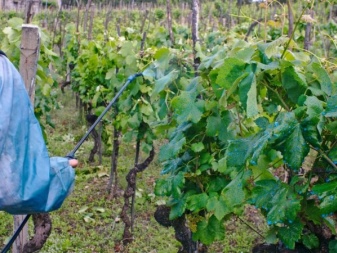

Why process?
Seasonal processing of grapes with copper sulfate is included in the list of measures necessary to maintain a healthy vine. This is one of the simplest and most affordable ways to protect plants from fungal diseases and pests that are destructive for them. Plants are sprayed with copper sulfate in horticulture, they are watered on poor clay and sandy soils. Cuttings or shanks also feel better during storage if they are first dipped in a 4% solution of this substance.
For a vineyard located not on black earth soils, the problem of copper shortage is always relevant. By spraying plants with preparations based on this substance, one can easily solve the problem of eliminating the deficiency that has arisen.
Copper sulfate belongs to water-soluble forms, is well absorbed, but does not penetrate into fruits. With a lack of it, plants slow down their development, stop bearing fruit, and can wither.
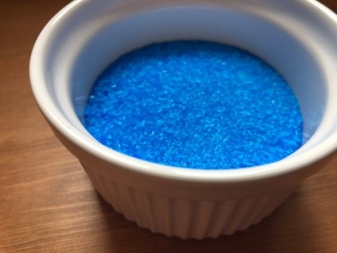
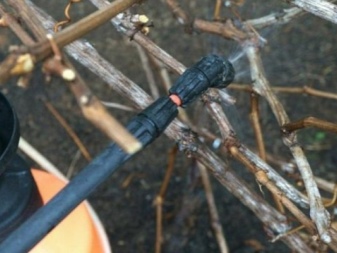
Processing with copper sulfate is necessary for grapes, as it performs several functions.
- Top dressing. By compensating for the lack of nutrients, it is possible to ensure the maintenance of high plant immunity.
- Sanitation. The use of copper sulfate allows you to treat the vine from fungal diseases, parasitic infections.
- Disease prevention. Pre-treatment can provide the best conditions for planting and cultivating young vines.
- Improving soil fertility. In this case, the solution is poured under the root, or the soil is treated before planting the vine.
Top dressing with copper sulfate is traditionally needed for soils with a predominance of peat or sand and clay in the composition. When using this substance, it is imperative to strictly follow the recommendations for its dosage.
Copper sulfate is effective against plant diseases such as scab, powdery mildew, mycosis, white or brown spot.
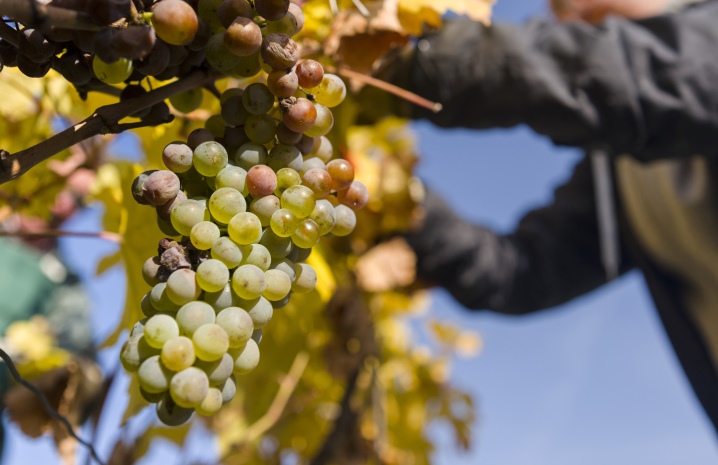
How to dilute?
It is possible to properly prepare a solution of copper sulfate for spraying, strictly observing the proportions and dosage of the substance. An aqueous suspension does not require a high concentration of active ingredient. It will be enough to dilute the product in a proportion of 5 g per 1 liter of liquid. This is the highest possible concentration, suitable exclusively for the autumn reorganization of old vines. For spring prophylaxis, a 1% solution (1 g per 1 liter of water) is sufficient; a suspension with a 3% content of copper sulfate is suitable for the destruction of fungus and diseases.
When preparing the preparation for watering, it is very important to use glass, non-oxidizing dishes. Iron and plastic can react with the drug. Crystalline blue powder dissolves better in warm water - this should be taken into account.
It is necessary to prepare a suspension of copper sulfate immediately before spraying or root application - in contact with air, the substance quickly loses its effectiveness.
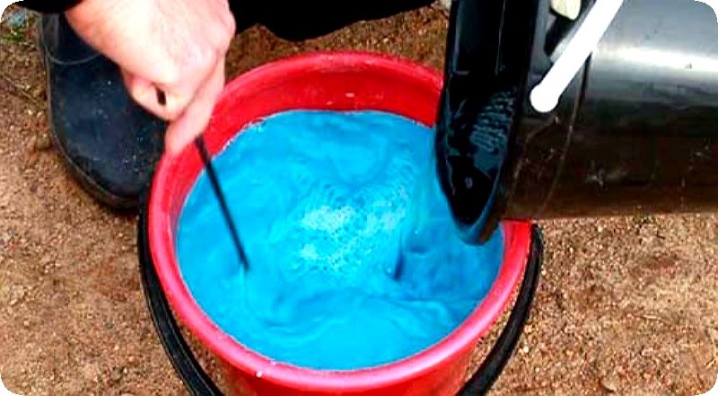
Instructions for use
You can process the vine with copper sulfate in the spring, summer or autumn months, depending on the purpose of fertilization. It is worth carefully choosing the period in which the impact will be performed. For example, if you sprinkle the solution on the leaves in the summer heat, they are more likely to be burned. If there is an urgent need for sanitation, the solution is simply diluted more - this measure avoids problems, but reduces the fungicidal effectiveness of the drug.
Copper sulfate is best applied in the form of fine droplets sprayed onto the affected areas of the vine. For these purposes, a special spray tank is used. Hand sprayers are handy for small areas. In large vineyards, backpack models with an increased tank capacity are more effective.
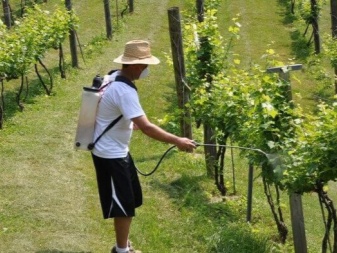
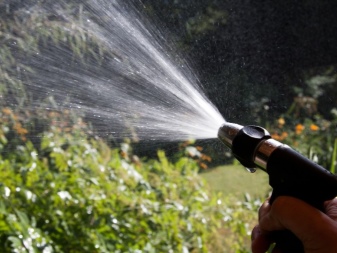
When treating with copper sulfate, it is important to pay attention to the thoroughness of the spraying. When destroying the fungus and treating diseases, it is necessary to spray at least 1.5 liters of suspension on each large shoot of grapes. The entire bush will require 4 to 5 liters of a 3% solution. In the absence of a sprayer at hand, you can apply copper sulfate to the vine using a short broom made of thin twigs. In this case, you should refuse to use a watering can - too large drops will burn the leaves.
If root top dressing is performed, it is recommended to isolate the soil under the bush from possible contact with the chemical used. For this, the surface of the soil is lined with a film, which is then removed.
It is important to follow the correct procedure: start spraying from the top of the bush, gradually moving to the shoots of the lower tier. The trunk and legs are processed last. It is necessary to hold the sprayer at a distance of 20 cm when performing work, directing its mouthpiece from the bottom up.
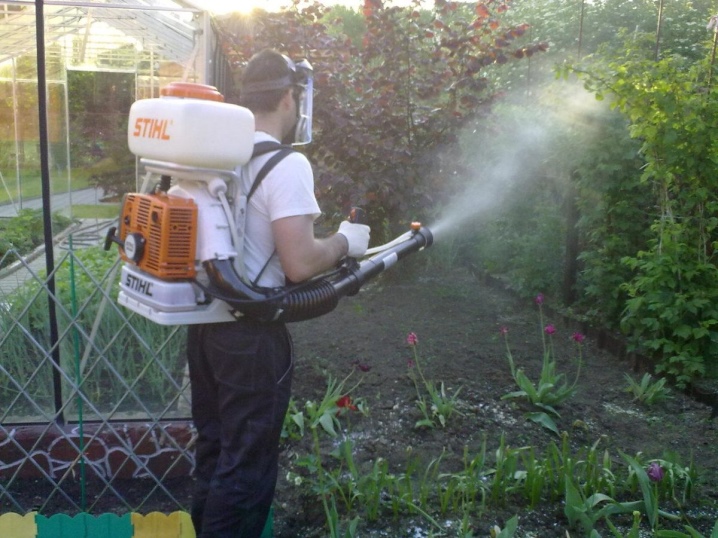
In autumn
Autumn processing of grapes with copper sulfate is considered one of the most important and significant during the year. An old vine before shelter for the winter needs full protection from fungi and parasites in the soil, as well as from their spores that spread through the air. It is carried out after the bush has completely shed its leaves. For the southern regions, this period begins at the end of November, in the middle lane, the last spraying with copper sulfate occurs in the third decade of October.
Before processing, the vine is carefully inspected. If necessary, pruning of dry, severely affected areas is performed. The remains of wilted foliage are removed from the branches, raked from the ground.
If left, insect larvae can easily appear in the rotting organic matter, looking for a convenient place for wintering.
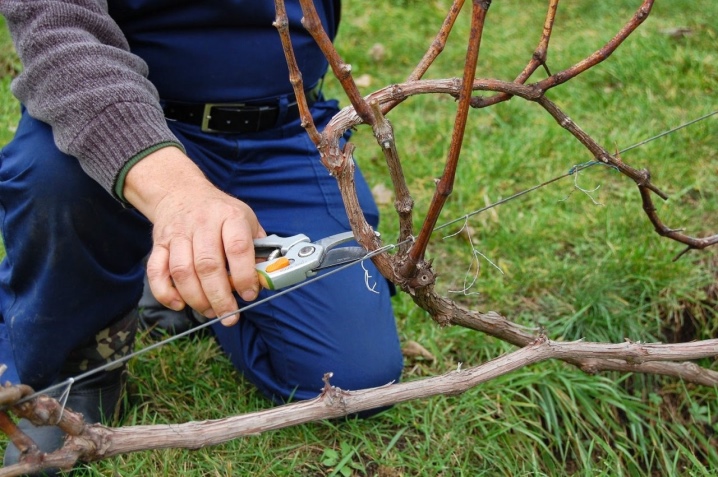
Bare branches are tied into bunches before spraying in autumn. Then a 5% solution of copper sulfate is sprayed onto each such structure. Since the leaves are gone in the fall, the concentration can be quite high.
Before sending the cuttings for storage, it is also recommended to spray them or simply dip the root part in a solution of copper sulfate. Such preventive measures are not at all superfluous, especially when you consider that it is young shanks that are most susceptible to fungal diseases. Weakened immunity does not allow them to effectively resist external threats. Neglecting sanitization will lead to the fact that plants may simply die.
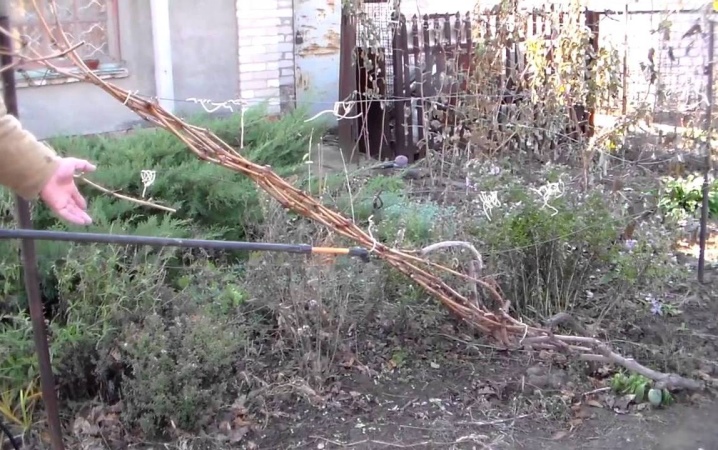
In the spring
Preventive spring treatment should be done as early as possible. The optimal time will be when the vine has not yet thrown out the buds. During this period, the sanitary measures taken are the most effective. After the buds bloom, it is no longer possible to use copper sulfate. It is recommended to set the processing time after waiting for the average daily temperature to be established above +5 degrees Celsius.
Spring and any other seasonal spraying should be done in dry and clear weather. If immediately after application of the drug it is washed off by rain, such measures will not bring benefits.All copper sulfate will enter the soil, oversaturation with chemicals.
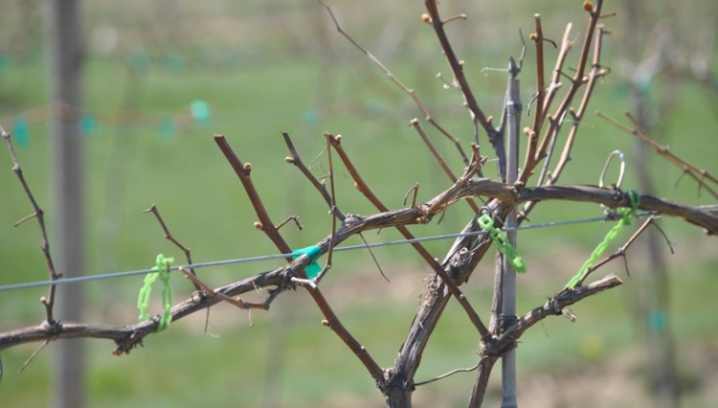
When processing grapes in spring, the correct procedure should be followed.
- Covering material is removed from the vine.
- The branches rise above the soil surface. Attached to pre-installed or left over from last year trellis.
- The vine is left to dry in the sun for 2-3 days. This will allow the plant to prepare for further awakening.
- After the specified time, a solution of copper sulfate is prepared. 1% concentration is enough. The drug is applied immediately, it cannot be stored.
When choosing the time of the first treatment, it is important to take into account the regional climatic features. In central Russia, this period begins in the third decade of March. In the south, spraying should be done at the end of February or a little later. For Siberia and the Urals, the processing time is postponed to the beginning of April, earlier the vine simply cannot be freed from the shelter due to the high risks of freezing.
If at the beginning of spring it was not possible to spray with copper sulfate, it can be carried out later - before flowering. The main purposes of processing in this case will be to protect the stalks from fungal infections and decay, increase the plant's immunity, and its resistance to parasitic infection. Spraying is carried out according to the standard scheme, from top to bottom, the props are also carefully covered with the drug - they often become sources of the spread of bacterial infections.
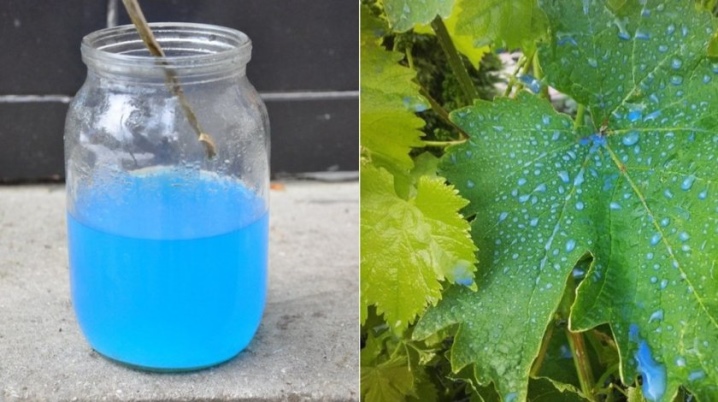
Spring is a good time to root the vines if needed. A lack of copper will be reported by pallor and uneven color of the leaves, weakness and thinning of the shoots. For root feeding, a suspension of copper sulfate at a concentration of 1% is used.
Summer
During the summer heat, any treatments are not recommended. But this time is favorable for the development and spread of grape diseases. If the damage to the vines is noticeable to the naked eye, a dry period should be chosen for spraying. Basically, for summer treatment, a solution at a concentration of 0.5% is used, but if the presence of oidium, lichens is detected, the proportions will have to be increased to 3 g of copper sulfate per 1 liter of water. Spraying is carried out in the evening, in calm, cloudless weather.
If the spring dates for introducing root dressing with copper-containing preparations have been missed, you can perform it in July. After the appearance of signs of a deficiency of this element in the soil, it is necessary to prepare a solution at a concentration of 0.2-0.3%.
A suspension of copper sulfate is introduced into the soil by a foliar method so as not to harm the plant.
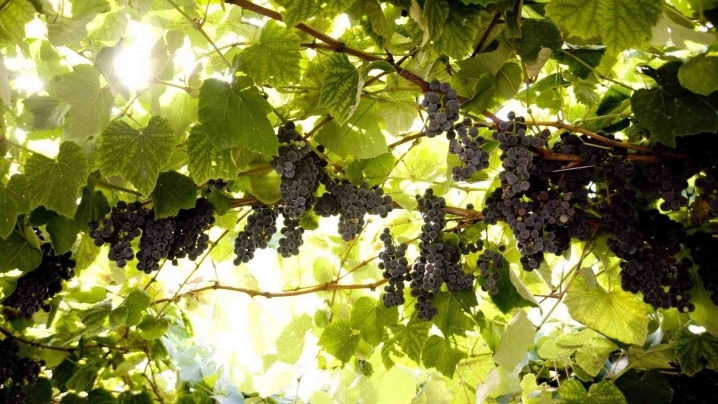
Safety regulations
Copper sulphate is a toxic substance, with which quite strict requirements are imposed on work. It is imperative to observe the exact concentration of substances, without changing the dosage at your discretion. At the same time, it is important not to forget about the rules of personal safety.
- When working with a chemicalwhether it is preparing a solution or spraying it, care must be taken to protect the body, hands and feet. Clothes should be as closed as possible, it is better to put on rubber boots or galoshes on your feet, and protect your body with a raincoat or work gown.
- Rubberized (doused) or nitrile gloves must be worn on hands. You can not dose copper sulfate without protective equipment. After work, even with gloves, hands must be washed with soap and water.
- In the process of spraying the plant, the hair must be protected with a hat or hood, respiratory organs - with a respirator or an individual mask that prevents inhalation of small drops of the solution. The eyes are protected with special glasses.
- It is forbidden to spray copper sulfate and compounds based on it in windy weather. This increases the likelihood of contact with the aqueous dispersion of the solution, which can be hazardous to health.
- In warm seasons, early morning or evening hours are chosen for spraying. This will avoid evaporation of the solution until it penetrates into the organs of the plant. In addition, during the day, you can corny harm the plant - the leaves will simply burn.
- Skin contact Copper sulfate, especially in high concentration, can cause burns because it contains sulfuric acid. If contact does occur, wash the body area thoroughly with soap and an antiseptic. If irritation or burns develop, seek medical attention.
- When washing off the solution with rain, do not repeat the treatment earlier than after 4 weeks. In this case, it is impossible to control the digestibility of copper, and its excess in the soil is no less dangerous than a shortage.
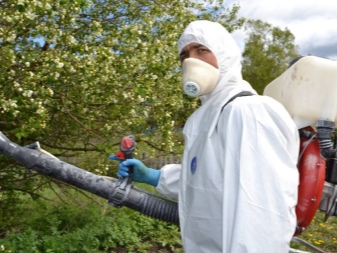
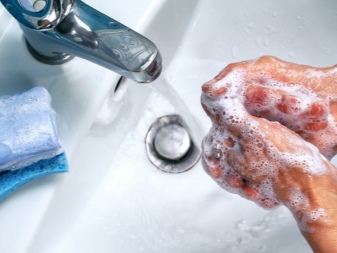
Considering all safety rules, you can use copper sulfate when processing vineyards without risking your own health and plant safety.
For information on how to process grapes with copper sulfate, see the next video.













The comment was sent successfully.